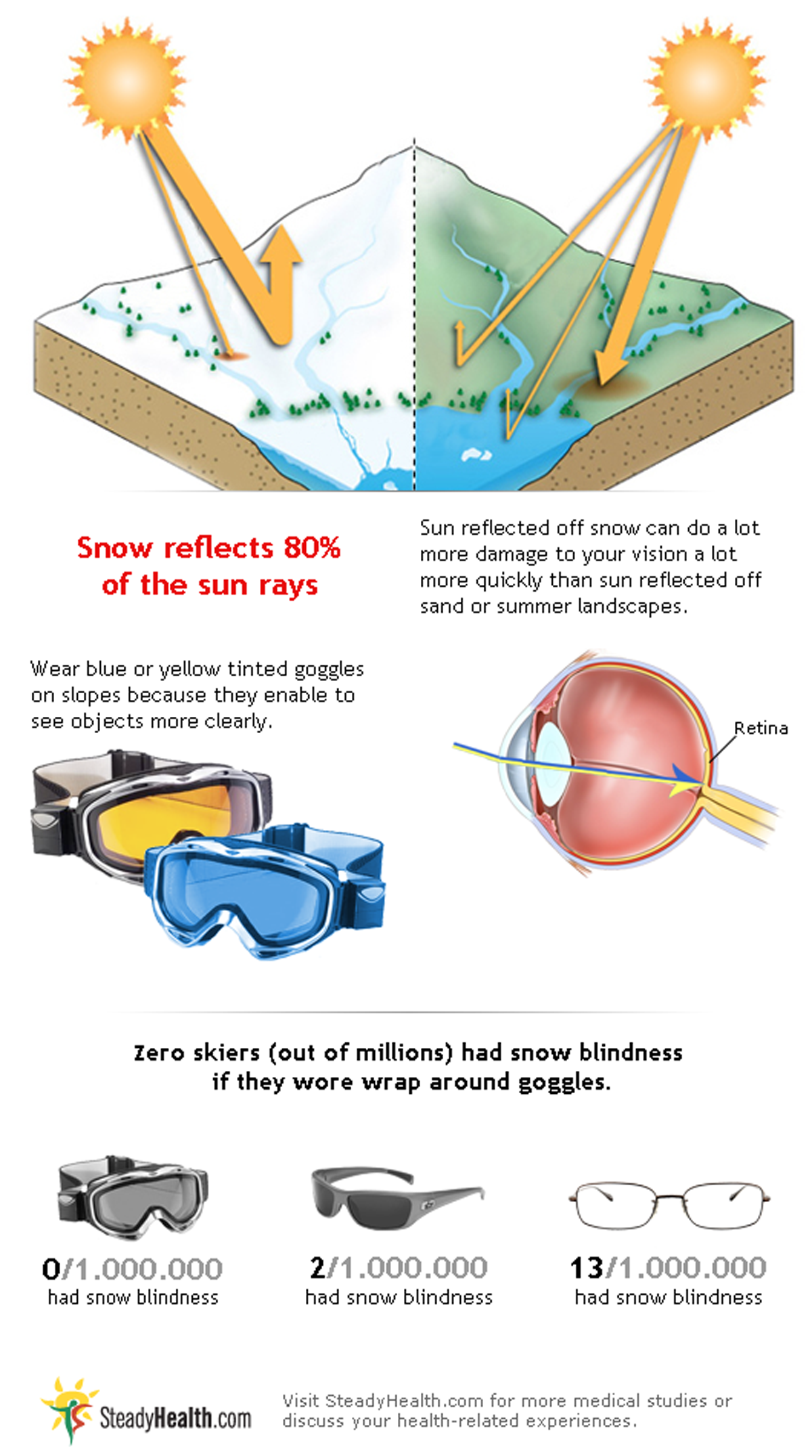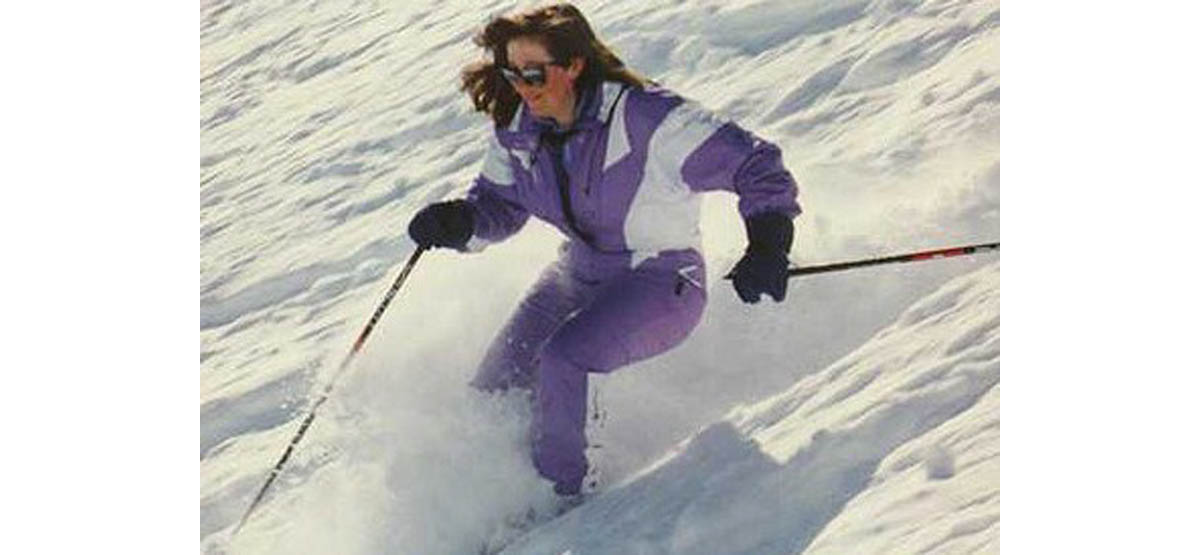Most people are quick to protect their eyes during hot summer days by wearing sunglasses. However, did you know that an hour on the snow can be harder on your eyes than an afternoon at the beach? You might be skeptical, but it's true.
Sun reflected off snow can do a lot more damage to your vision a lot more quickly than sun reflected off sand or summer landscapes. How? The intense light reflected from the snow can cause snow glare, snow blindness, or snow keratopathy, all of which can temporarily or sometimes even permanently damage your sight.
If you're not protecting your eyes during snowy days, then you should start now. It's just as important as wearing sunglasses, if not more. How exactly can you protect your eyes from snowy weather, though? Let's take a look at ten of the best ways to protect your eyes during snowy winter days.

Snow Glare
A coating of snow reflects nearly 80 percent of the sun's rays. This means that your eyes receive 80 percent more light on a clear day when the ground is covered with snow than they do on a clear day when the ground is covered with grass.One of the most obvious visual problems on bright days during snow season is glare. Glare is caused by the differing rates of reflectivity of snow and surrounding objects. Snow reflects more light than trees, oncoming cars, pedestrians, light poles, and other people out enjoying winter activities do. The intensity of light reflected off the snow makes other objects appear to wash out or even disappear altogether. When the sun rolls behind the clouds, or any time at night, glare is greatly reduced. The effects of glare will stop as soon as soon as you go inside.
Snow Blindness
The retina is the collection of cells at the back of the eye that convert light into electrical signals to send to the brain. The center of the retina receives the most light. It is especially sensitive to blue and yellow light. That's why people wear blue or yellow tinted sunglasses when they go out into the snow. Filtering out most of the light that is not blue or yellow makes it easier to see objects directly ahead, in the middle of the field of vision. Otherwise, it's easy to ski into a tree or drive into a moose that you simply don't see in the glare.The older you are, the more the lens of your eye scatters light across your retina. Because older eyes receive more of the glaring light snow reflects, it takes up to 3 times longer for someone who is 60 to recover normal vision after being exposed to snow glare than it takes someone who is 16. The ability to see details recovers as the effects of glare wear off. This kind of snow blindness is temporary, but another kind of snow blindness is not.
Snow Keratopathy
The wavelengths of UV light reflected off snow usually do not cause cancers. They do, however, cause the same kinds of damage to the lens and retina of the eye as occur after exposure to high-intensity light from Halogen lamps, arc welders, and lightning. Fortunately, this kind of damage is usually limited to the cornea. If the eye suffers only a single exposure to high-intensity UV light, usually it will begin to repair itself in 36 to 72 hours. Blindness from a single exposure is very rare. However, repeated exposure can lead to loss of sight. Fortunately, there are many ways to prevent problems caused by intense sunlight reflected off the snow.
The Ten Things You Need to Know to Prevent Snow Blindness
The human eye simply was not designed to operate in bright sunlight reflected off white snow. Fortunately, there are 10 ways to stop vision problems in snow season.

1. The worst symptoms of snow blindness may not be noticeable until 6 to 12 hours later.
You may be able to spend your day in the snow with no problems at all, only to suffer blurred vision, double vision, spasms of the muscles around the eyes, pain, itching, irritation, tears, and decreased visual acuity in the middle of the night. The worst snow-related vision problems usually don't provide early warning signals.2. Moisture accelerates healing from eye injuries.
It used to be that if you went into the emergency room to get treatment for damage to your cornea from UV light exposure the doctor would apply a dressing directly to your eye and put a bandage over the dressing, keeping your eye open, for 24 hours. Many people found the treatment worse than the disease.Nowadays, doctors recognize that the cornea heals more quickly when it the eye is not bandages. Sterile eye drops and keeping moisture in the air while indoors will accelerate healing. If you are staying in a building heated with a forced-air heating system, you will probably get better faster if you use a vaporizer or humidifier.
3. Topical pain relievers are usually not designed for eye pain.
There are topical Tylenol and topical Ibuprofen products doctors sometimes apply directly to the eye to relieve pain, but don't try this at home. And don't sneak out of the emergency room with the doctor's bottle of pain relief gel. Applying it at home can cause infections.4. UV protection is essential for high-altitude skiing (and any activity in the Arctic or Antarctic when the sun is shining).
Wrap-around goggles with UV protection are a must when UV levels are high and the landscape is covered with snow. Most high-altitude sports participants will have the goggles, but they will be tempted to take them off when they fog up or when it's cloudy. Don't do this. At high altitudes, the are potentially harmful amounts of UV in sunlight even on a cloudy day. You may not notice any problems at the time, but the next day your eyes may be a mess.5. Polarized sunglasses offer more protection than ordinary sunglasses.
Snow reflects sunlight in every direction. Polarized sunglasses remove some of the "stray" reflections to limit the amount of light hitting your eyes. Regular sunglasses just make glare dimmer, but polarized glasses eliminate it.6. You can easily determine whether your sunglasses are polarized.
Not sure whether your glasses are polarized? Take them off and look through them out a window. Turn the glasses slowly and see if the intensity of light changes. If it does, the glasses are polarized.7. Sunglasses don't help when the sun is low in the sky.
Polarized sunglasses are great for driving when the sun is relatively high in the sky. They are of maximum benefit when the sun is 37° above the horizon, about where it is as high noon in most ski areas. Cars and shiny objects in front of you reflect sunlight in a horizontal plane and your polarized sunglasses eliminate glare in the vertical plane so you get the maximum benefit from wearing them at midday.When the sun is low in the sky, however, the glare from cars and metallic objects shines up and down rather than right and left. At dawn and at dusk, sunglasses limit your vision even if there is glare form the snow.
8. Snow goggles should be vented.
When you're wearing snow goggles, you don't want them to fog up. You especially don't want the fog to freeze on your glasses. Snow goggles that are vented at the bottom of the wrap-around, not the top, let moisture escape so it does not fog or freeze.9. Snow goggles should be flexible even when it's cold.
It doesn't do you a lot of good to wear goggles if the frames snap when they are exposed to extreme cold. Fleece to protect the skin at points of contact also makes goggles much more comfortable.10. Fluffy and Fido need eye protection too.
If you're taking pets with you on your winter vacation, don't forget that they need eye protection, too. Optical products makers make snow vision protection for cats and dogs that can save them from eye pain and even loss of sight if they spend a lot of time in bright light reflected from the snow. Of course, you can always just keep your pets inside.Just how common is snow blindness that is bad enough to require emergency room treatment? Fortunately, the answer is not very. The University of Utah treated just 15 cases in 25 years—13 of them skiers who did not wear any glasses or goggles at all, and 2 who wore glasses without side protection.
- McIntosh SE, Guercio B, Tabin GC, Leemon D, Schimelpfenig T. Ultraviolet keratitis among mountaineers and outdoor recreationalists. Wilderness Environ Med. 2011 Jun.22(2):144-7. Epub 2011 Jan 14.
- Photo courtesy of cernese on Flickr: www.flickr.com/photos/cernese/83840612/

